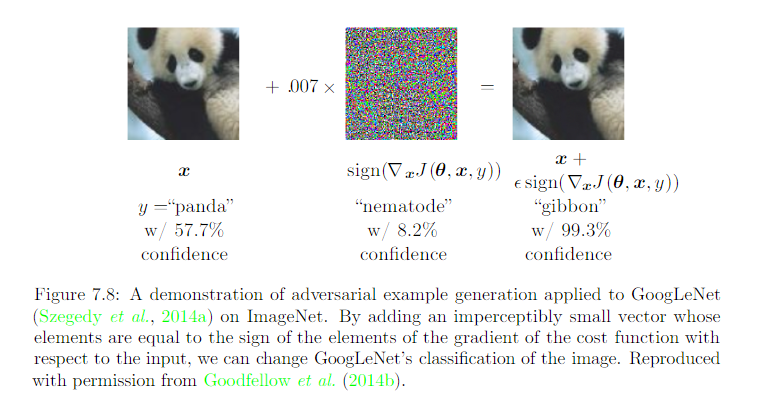Adversarial Learning¶

(image: https://www.flickr.com/photos/sbfisher/856125311, Creative Commons License)
Topics¶
- Adversarial examples
- Generative Adversarial Networks
Adversarial Examples¶
Data inputs that fool neural networks, but not people

(image: Deep Learning, Ian Goodfellow and Yoshua Bengio and Aaron Courville)
Walkthrough - Adversarial Examples¶
In this walkthrough, we will see how a Neural Network handles adversarial examples.
- Get predictions for an image
- Convert image to an adversarial example
- Re-evaluate the adversarial example
Setup - Install Foolbox¶
Foolbox is a Python toolbox to create adversarial examples that fool neural networks.
https://github.com/bethgelab/foolbox
pip install foolboxdef resize_and_crop_image(image_path, width, height):
"""Resizes and crops an image to the desired size
Args:
image_path: path to the image
width: image width
height: image height
Returns:
the resulting image
"""
from PIL import Image, ImageOps
img = Image.open(image_path)
img = ImageOps.fit(img, (width, height))
return img
# 1. Get predictions for an image
from keras.applications import ResNet50
from keras.applications.resnet50 import preprocess_input, decode_predictions
from keras.preprocessing.image import img_to_array
import matplotlib.pyplot as plt
import numpy as np
model = ResNet50()
width = height = 224
image_path = './assets/adversarial/mrt.jpg'
img = resize_and_crop_image(image_path, width, height)
plt.imshow(img)
x = img_to_array(img)
x = preprocess_input(x)
x = np.expand_dims(x, axis=0)
y = model.predict(x)
preds = decode_predictions(y, top=1)
plt.title('Original: %s' % preds)
plt.axis('off')
plt.show()
from keras.backend import set_learning_phase
from PIL import Image
import foolbox
# labels from Keras
# https://s3.amazonaws.com/deep-learning-models/image-models/imagenet_class_index.json
label = 829 # "829": ["n04335435", "streetcar"]
# Example from: https://github.com/bethgelab/foolbox
set_learning_phase(0) # not training
# Element-wise preprocessing of input
# first subtracts the first element of preprocessing from the input
# and then divide the input by the second element.
# https://foolbox.readthedocs.io/en/latest/modules/models.html#foolbox.models.KerasModel
preprocessing = (np.array([104, 116, 123]), 1)
fmodel = foolbox.models.KerasModel(ResNet50(), bounds=(0, 255),
preprocessing=preprocessing)
# Apply attack on source image to target a different label
attack = foolbox.attacks.FGSM(model=fmodel)
img = resize_and_crop_image(image_path, width, height)
x = np.asarray(img, dtype=np.float32)
x = x[:, :, :3]
# ::-1 to convert BGR to RGB
adversarial = attack(x[:, :, ::-1], label)
# ::-1 to convert BGR to RGB
# division by 255 to convert [0, 255] to [0, 1]
plt.imshow(adversarial[:, :, ::-1] / 255)
x = preprocess_input(adversarial)
y = model.predict(np.expand_dims(x, axis=0))
preds = decode_predictions(y, top=1)
plt.title('Adversarial: %s' % preds)
plt.axis('off')
plt.show()
Optional Exercises¶
The Foolbox tool kit has a few other exploits available. These are useful if we want to create adversarial inputs to augment our training data (https://github.com/bethgelab/foolbox/issues/81)
- Try other attacks available in Foolbox, such as LBFGSAttack, which tries to fake a target class.
criterion = foolbox.criteria.TargetClass(22) attack = foolbox.attacks.LBFGSAttack(fmodel, criterion)
- Try other image classes as practice. For a given text label, you can find the integer label by download this file:
Generative Adversarial Networks (GANs)¶
- Train two networks against each other
- Generator: generates fake images to fool Discriminator
- returns samples
- Discriminator: tries to distinguish real images from fake ones
- returns probability that sample is real
Objective¶
Training is done (converged) when:
- Generator's fake samples are indistinguishable from real samples
- Discriminator always returns $\frac{1}{2}$
Discard Discriminator and keep the Generator as the finished model.
Applications¶
Fake celebrities: https://www.theverge.com/2017/10/30/16569402/ai-generate-fake-faces-celebs-nvidia-gan
Image synthesis: https://arxiv.org/abs/1803.04469
Text to Speech: https://github.com/r9y9/gantts
Workshop: Training a DCGAN¶
Deep Convolutional GAN: https://arxiv.org/abs/1511.06434
from keras.layers import Input, Dense, Reshape, Flatten, Dropout
from keras.layers import BatchNormalization
from keras.layers.advanced_activations import LeakyReLU
from keras.models import Sequential, Model
from keras.optimizers import Adam, RMSprop
import numpy as np
import matplotlib.pyplot as plt
Dataset: MNIST¶
Training GANs is tricky, so we will try to reproduce it with a well-known dataset (MNIST).
Input: 28x28 pixel, black and white images of handwritten digits
Ouptut: 10 labels (0 to 9)
from keras.datasets import mnist
width = height = 28
channels = 1
shape = (width, height, channels)
(X_train, _), (_, _) = mnist.load_data()
# Rescale -1 to 1
X_train = (X_train.astype(np.float32) - 127.5) / 127.5
X_train = np.expand_dims(X_train, axis=3)
Create models¶
def generator():
"""Defines a Generator model"""
model = Sequential()
model.add(Dense(256, input_shape=(100,)))
model.add(LeakyReLU(alpha=0.2))
model.add(BatchNormalization(momentum=0.8))
model.add(Dense(512))
model.add(LeakyReLU(alpha=0.2))
model.add(BatchNormalization(momentum=0.8))
model.add(Dense(1024))
model.add(LeakyReLU(alpha=0.2))
model.add(BatchNormalization(momentum=0.8))
model.add(Dense(height * height * channels, activation='tanh'))
model.add(Reshape((width, height, channels)))
return model
def discriminator():
"""Defines a Discriminator model"""
model = Sequential()
model.add(Flatten(input_shape=shape))
model.add(Dense((width * height * channels), input_shape=shape))
model.add(LeakyReLU(alpha=0.2))
model.add(Dense((width * height * channels)//2))
model.add(LeakyReLU(alpha=0.2))
model.add(Dense(1, activation='sigmoid'))
return model
Adversarial Model¶
The adversarial model is created by chaining the generator with the discriminator.
- Input goes into the Generator, which tries to make it fake
- The output from the Generator will be fed into the Discriminator, which tries to discriminate the fake images from real ones.

(image: https://towardsdatascience.com/gan-by-example-using-keras-on-tensorflow-backend-1a6d515a60d0)
Exercise - Create Adversarial Model¶
Create our stacked adversarial model as shown in the picture above.
Steps
Create and compile the generator with
binary_crossentropyloss andAdam(lr=0.0002, decay=8e-9)optimizerCreate and compile the discriminator with
binary_crossentropyloss andAdam(lr=0.0002, decay=8e-9)optimizerChain the two into a
Sequential()adversarial model, and compile it.- For the adversarial model, the discriminator's weights should be frozen.
You can refer to https://medium.com/@mattiaspinelli/simple-generative-adversarial-network-gans-with-keras-1fe578e44a87 if you are stuck.
# Your code here
def plot_images(samples=16, step=0):
"""Plots the generated images at the given step
Args:
samples: number of images to generate
step: step count
"""
import matplotlib.pyplot as plt
noise = np.random.normal(0, 1, (samples,100))
images = gen.predict(noise)
plt.figure(figsize=(10,10))
for i in range(images.shape[0]):
plt.subplot(4, 4, i+1)
image = images[i, :, :, :]
image = np.reshape(image, [height, width])
plt.imshow(image, cmap='gray')
plt.axis('off')
plt.tight_layout()
plt.show()
Training Setup: Sanity Check¶
To make sure our training code works, we'll do a sanity check with very few epochs and a tiny batch size.
epochs = 20 # small number for workshop purposes, typically 20000
batch = 4 # small number for workshop purposes, typically 32
plot_interval = 200
for cnt in range(epochs):
# Get real images
random_index = np.random.randint(0, len(X_train) - batch//2)
legit_images = X_train[random_index : random_index + batch//2].reshape(batch//2, width, height, channels)
# Have the generator predict fake images
print('epoch: %d, [Generating images, batch size: %d]' % (cnt, batch))
gen_noise = np.random.normal(0, 1, (batch//2,100))
synthetic_images = gen.predict(gen_noise)
x_combined_batch = np.concatenate((legit_images, synthetic_images))
y_combined_batch = np.concatenate((np.ones((batch//2, 1)), np.zeros((batch//2, 1))))
# Train the discriminator with the fake images and the real images
# perform 1 gradient update on this batch
print('epoch: %d, [Training Discriminator, batch size: %d]' % (cnt, batch))
dis_loss = dis.train_on_batch(x_combined_batch, y_combined_batch)
# Train the generator (which is embedded in the Adversarial network)
# For the Adversarial network, the discriminator weights are frozen.
noise = np.random.normal(0, 1, (batch,100))
y_mislabeled = np.ones((batch, 1))
# perform 1 gradient update on this batch
print('epoch: %d, [Training Generator, batch size: %d]' % (cnt, len(x_combined_batch)))
gan_loss = gan.train_on_batch(noise, y_mislabeled)
print('epoch: %d, [Discriminator loss: %.3f], [ Generator loss: %.3f]' % (cnt, dis_loss[0], gan_loss))
# show progress
if cnt % plot_interval == 0 :
plot_images(step=cnt)
Exercise - Train model¶
Now that we've run through a quick sanity check, try setting epochs and batch to larger values
epochs = 20 # small number for workshop purposes, typically 20000
batch = 4 # small number for workshop purposes, typically 32Warning: training will be slow on CPU-only machines. You can try gradually bumping up the epochs / batch values.
Another option is to look into running this on a GPU machine, using a service such as: https://neptune.ml/
Reading List¶
| Material | Read it for | URL |
|---|---|---|
| Section 7.13 Adversarial Training (Pages 265-266) | How to improve network robustness with adversarial examples | http://www.deeplearningbook.org/contents/regularization.html |
| Section 7.13 Generative Adversarial Networks (Pages 696-699 | Introduction to GANs (motivation, challenges), written by the inventor of GANs | http://www.deeplearningbook.org/contents/generative_models.html |


